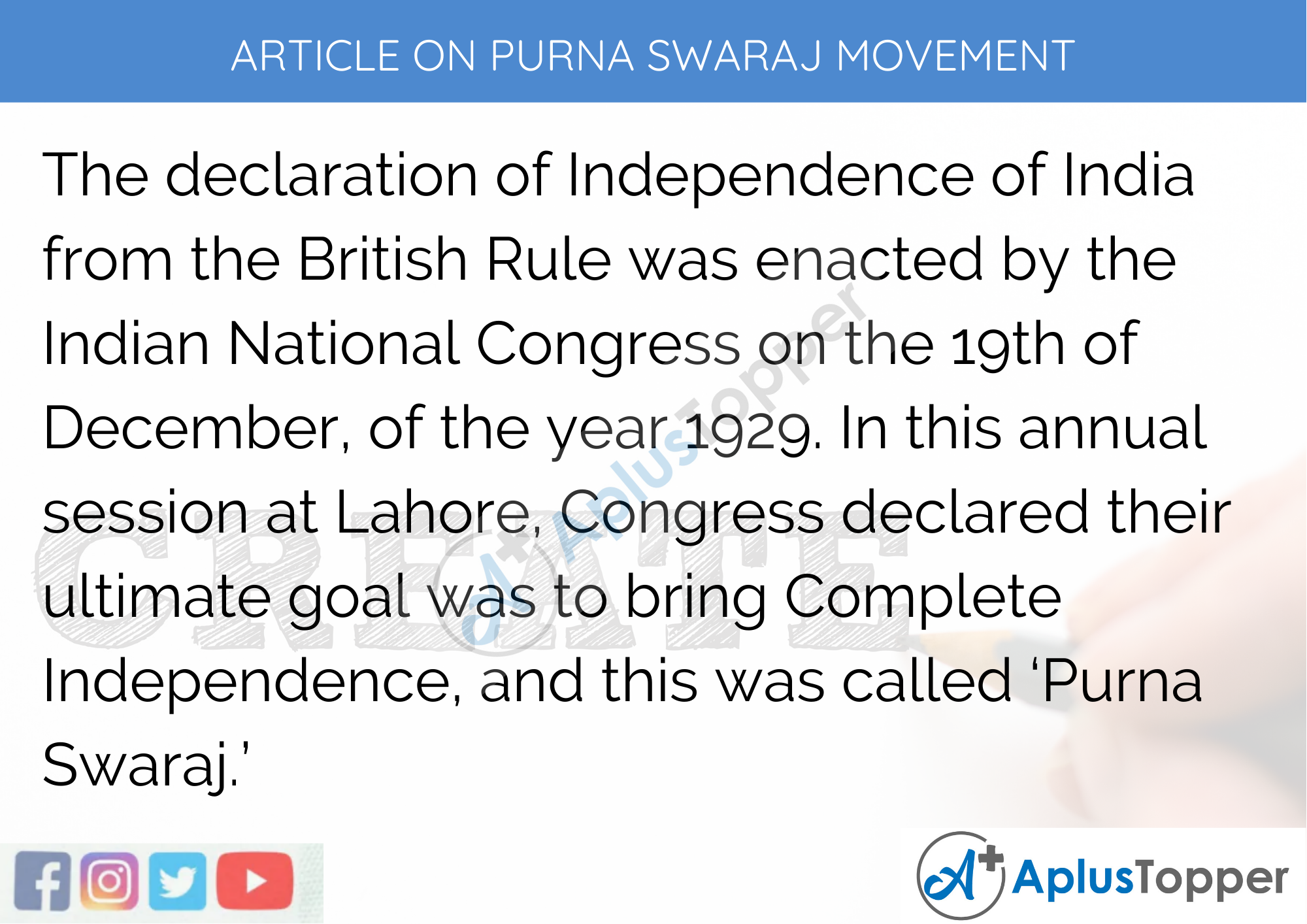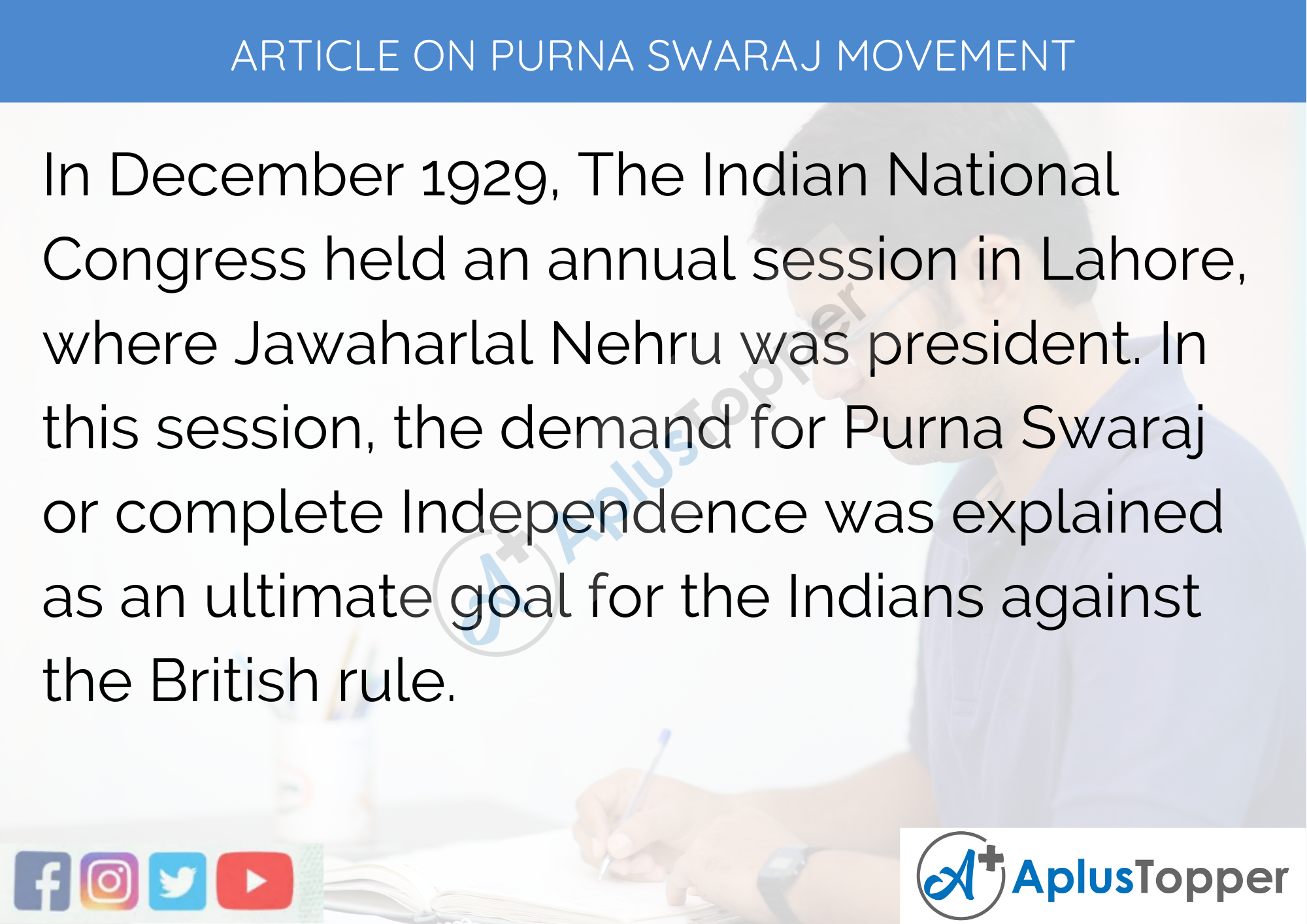Article On Purna Swaraj Movement: The meaning of Purna Swaraj explained about the declaration of complete Independence in India. It was started by the Indian National Congress on December 19th, 1929, trying to convince every Indian citizen to fight against British for complete Swaraj. Jawaharlal Nehru hoisted the Indian flag on 31st December 1929 on the sides of the river Ravi. There was a 750-word document resolution, which is a manifesto claiming Purna Swaraj or complete Independence. Several movements took place for achieving this demand by the leaders and people of India. The document spoke the intentions of the Indians and their precise demands of independence.
You can read more Article Writing about people, sports, technology many more.
Long And Short Articles On Purna Swaraj Movement for Students and Children in English
The Purna Swaraj Movement is an essential part of the history of Independence of India, which should be known by every Indian citizen. Students who go to schools can get asked to write articles on the subject for their assignments and exams. The long Article on Purna Swaraj Movement are useful to people studying in classes 7, 8, 9, and 10. On the other hand, the short Article on Purna Swaraj Movement are common among students of classes 1, 2, 3, 4, 5, and 6.

Long Article On Purna Swaraj Movement 500 Words In English
The declaration of Independence of India from the British Rule was enacted by the Indian National Congress on the 19th of December, of the year 1929. In this annual session at Lahore, Congress declared their ultimate goal was to bring Complete Independence, and this was called ‘Purna Swaraj.’
The Purna Swaraj was immensely required because of the British oppression of Indians. The British ruined the economy, politics, culture, and spirituality of India and deprived them of their freedom.
And the British consistently denied the Indian people and parties of the fundamental political rights by persistently ignoring them. This resulted in the growth of cohesion in the Indian National Congress regarding a common desire that is the complete overthrow of the British from India.
The Lahore session of Congress was attended by several volunteers and delegates of Congress and other political parties. In the massive public session, all nationalists and Congressmen were asked to resign from the legislatures, and that also meant not to participate in the legislatures’ elections.
The Congress Working Committee then included veteran leaders like Sardar Vallabbhai Patel and Chakravarthi Rajagopalachari, who were all unified under the elected president of Congress that was Jawaharlal Nehru. And the Purna Swaraj was approved by all of them.
The manifesto of the ‘Indian Declaration of Independence’ was a 750 words long document. This document contained no constitutional or legal structure. However, the document called for several ties with the British claiming complete independence.
The Purna Swaraj document demanded freedom of social, financial, political, and living standards of Indians. The document demanded all the fundamental rights of the Indian people they were deprived of during British rule.
Nehru hoisted the newly adopted tri-color flag of India on 31st of 1929’s December on the banks of Ravi in Lahore. This ceremony was attended by a massive crowd of people who gave their approval to the pledge by raising their hands.
The pledge read on the Ravi bank stated the submission to British power any longer would mean doing a crime against God and the people. The pledge also included the pledge takers’ readiness towards acts like withholding of taxes to rebel against British rule. The objective behind this event was to get complete freedom from British power.
This resolution that symbolized the Indian public sentiment back then was supported by the resignation of 172 Indian members from their post in the central and provincial legislatures.
However, the official promulgation of the declaration of Independence was done on 26th January of 1930, when Congress asked the people of India to observe that day as Independence Day of India. Nationalists launched the mass civil disobedience movement on the same day. Hence this day is marked a red-letter day in Indian history.
The complete Indian Independence declared by Congress on 26th January of the year 1930 was a significant igniting factor for raising the sense of nationalism among the Indian public. Several impactful movements followed this event, which eventually did win us our official Independence in 1947.
Short Article On Purna Swaraj Movement 300 Words in English
In December 1929, The Indian National Congress held an annual session in Lahore, where Jawaharlal Nehru was president. In this session, the demand for Purna Swaraj or complete Independence was explained as an ultimate goal for the Indians against the British rule. This demand asked all the nationalists and Congress members, along with the involvement of Indian citizens, to participate in the legislative elections and to resign from the legislatures. They considered 26th January would be Independence Day of India, and to achieve this demand, they launched a Civil Disobedience Movement held by the Indian National Congress involving every Indian citizen.
At midnight of the eve of New Year, Jawaharlal Nehru raised the tricolor flag of India in the Ravi river banks in Lahore, which is now part of Pakistan. A large gathering was noticed attending that ceremony, and as a sign of approval, everybody raised their hands. The Indian leaders never believed in violence but believed in the Non-Cooperation Movement to get their independence.
The resolution, which was made, was of 750-word document as a type of manifesto explaining their rights and demands from the British people. They claimed independence in this draft and showed concern over the economic, political, and cultural crisis they are facing. The document spoke on behalf of every citizen of India and launched the emergence of civil disobedience movement very clear.
The Indian National Congress regularly observed 26th January as their Independence day by doing different campaigns and movements. Finally, in 1947, The British agreed to the transfer of power, ultimately making India a free country. However, there was no constitutional draft of India. An official constitutional draft was made, agreed, and from 26th January 1950, the declaration of India constitution occurred, making India a republic country. Now, every year of 26th January, we all India celebrate the national holiday enthusiastically.

10 Lines On Purna Swaraj Movement In English
- In 1922, Mahatma Gandhi first explained the meaning of Swaraj, which indicated the making of their constitution by Indians.
- In 1928, the first draft of the constitution was made by Jawaharlal Nehru, headed by Moti Lal Nehru.
- After a year, a session at Lahore was held demanding the Purna Swaraj resolution.
- This demanded the participation of every citizen of India for its success.
- The Indian National Congress organized the Civil Disobedience Movement for Swaraj to be successful.
- Several movements and sacrifices were made for making the movement successful.
- The Indian members of the British legislatures resigned from their positions.
- The draft clearly stated about the rights of the Indians and their freedom.
- All Indians came together to make this movement successful.
- It was not just freedom, but the making of the constitution of India is an important part.
FAQ’s on Article on Purna Swaraj Movement
Question 1.
By whom, Purna Swaraj was declared?
Answer:
The Indian National Congress declared the Purna Swaraj for India.
Question 2.
When was Swaraj first demanded?
Answer:
1906 was the year when Swaraj was first demanded.
Question 3.
Who made the first draft of the constitution?
Answer:
Jawaharlal Nehru first made the draft of the Indian Constitution demanding Purna Swaraj.
Question 4.
Which movement took place demanding Purna Swaraj?
Answer:
Civil disobedience movement took place demanding Purna Swaraj.
